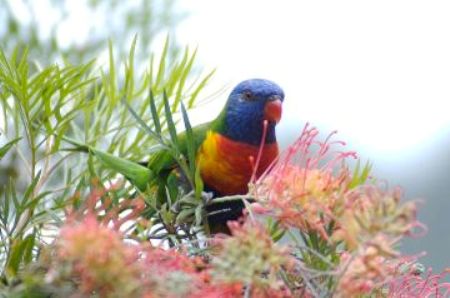All about the rainbow lorikeet:
Classification Information- Where do they fit in?
Domain- Eukarya
Phylum- Chordata
Subphylum- Vertebrata
Class- Aves
Order- Psittaciformes
Family- Psittacidae
Subfamily- Loriinae
Genus- Trichoglossus
Species-
Trichoglossus haematodusThe rainbow lorikeet, Trichoglossus haematodus, and sometimes called a rainbow for short, belongs to the Eukarya domain because of its cells have nuclear envelopes, as well as membrane-bound organelles. It is found in the the Animalia kingdom because of its multicellularity, and the fact that it is heterotrophic and mobile at some point during its lifetime. Chordata is the phylum the rainbow lorikeet belongs to because of the presence of 5 characteristic traits: 1.) a dorsal hollow nerve chord, 2.) a notochord, 3.) pharyngeal pouches, 4.) a post anal tail, and 5.) an endostyle. Rainbows belong to the subphylum Vertebrata because they have a vertebrae and a cranium. It is found in the Aves class because of the fact that it is endothermic, along with the presence of feathers and a large breast bone, which allows the wings to flap. A rainbow lorikeet's order is Psittaciformes, which are what we know to be the parrots. They usually have colorful patterns and hinged upper mandibles. The family Psittacidae, which are the "true parrots", is where the rainbow lorikeet is classified next. These animals are known to have deep bills. The lorikeets, or subfamily Loriinae, is the next classification for rainbows. Lorikeets exhibit slender, wavy-edged beaks and brush-tipped tongues. Rainbow lorikeets are placed in the genus Trichoglossus, and lorikeets in this genus have the presence of hairy tongues covered with fleshy bristles known as "papillae". Finally the rainbow lorikeet, Trichoglossus haematodus, is different from all other species in the Trichoglossus genus because of its dark chin and throat and green nape-band.
Click here to see where the rainbow lorikeet fits on a phylogenetic tree.
